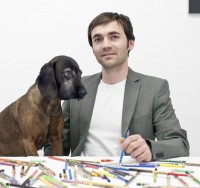Crossing Boundaries: A Conversation with Artist Slawomir Elsner
Slawomir Elsner’s painting exhibit, Collecting Images, will be on display at the Marc Jancou Contemporary gallery (524 West 24 Street NYC) through July 29. A stirring exhibit about tradition, new trends, and seeing things that aren’t there, Images presents a balance and play between nostalgia and provocation that is hard to resist.
Born in 1976 in Wodzislaw, Poland, Elsner moved to Germany with his family as a child. He studied at the Academy of Fine Arts, Kassel from 1995-2002, and now lives and works in Berlin as a painter, illustrator, and photographer. His paintings and drawings are often based on his own photographs, and presented in series format. Elsner’s work has been exhibited widely throughout Europe, including a popular exhibit called Seven Rooms in Grandfather’s House in 2000 based on photographs inspired by illustrations of Hans Christian Andersen’s fairy tales. According to a press release issued by the Marc Jancou Contemporary gallery, Elsner was more recently the subject of a solo exhibition, “Paris – Berlin – Warszawa,” at the Polish Institute in Berlin, and was included in a group exhibition at the Museum Folkwang, Essen honoring pas recipients of the prestigious Kunsthaus Essen scholarship.
GALO’s Anna Antoniak spoke with the artist about his current projects, and more personally, his connection to Poland and Germany.
GALO: How would you explain the Collecting Images exhibit in a sentence or two?
Slawomir Elsner: I’d have to pose the question back to you. I created the pieces, but the commentary, I leave to the audience.
GALO: Is there a sequence in which you painted the pieces in this exhibit?
SE: There’s no significant sequence. I worked on the drawings and painting simultaneously.
GALO: How do you relate the batch in one room to the grouping in the other?
SE: There isn’t a necessary connection, and yet one exists due to the lack of a central image. This very absence is what brings a new image into existence.
GALO: Is there a direct root of inspiration for it?
SE: Modern life, works that might inspire sensitivity to our surroundings.
GALO: Time Out New York described your Collecting Images exhibit as “kid-friendly.” Would you agree?
SE: Why wouldn’t I?
GALO: Is there a city you haven’t exhibited yet where you would like to? Why?
SE: Every city is unique in its own way and can be a special place.
GALO: How has growing up outside Poland influenced your relationship with the country and culture?
SE: Growing up in Germany and [with a] Polish heritage resulted in an ongoing connection with both countries, thanks to which I had a chance to see everything with dual perspectives. To recognize the differences as well as similarities, one learns more and has the opportunity to familiarize oneself with various traditions, which undoubtedly influenced my work.
GALO: What is exciting about being an artist in Berlin today?
SE: I personally don’t experience it so much emotionally, but I think that what Paris was at the turn of the 19th century is happening now in Berlin.
GALO: Your drawings and paintings tend to be incredibly realistic – heavily modeled after photographs. How do you feel about more abstract work?
SE: I think I’m surrounded by a mostly realistic world. Abstraction is another view of the world. In that way I appreciate post-war German and European abstraction!
GALO: At what point do you feel finished with a piece?
SE: When I make a copy of it or take its picture.
GALO: Do you find one particular medium more difficult to work with than another? Tell us a little about your process.
SE: Depending on the topic, I employ various mediums – mainly drawing, painting and photography. I also work in public spaces, just like the current mural in Katowice (Poland) — this is painting on an outdoor wall, but it’s not about painting so much as senstivity to the world around us.
GALO: Is there a color you have a particular weakness for?
SE: That depends on my mood and several other factors.
GALO: Is there a medium you haven’t explored yet that you’re curious about?
SE: Currently, I am engaged again in intensive drawing. The technique is specific, and the motives, as Jean-Christophe Ammann said, are to take oneself to the level of performance, literally taking part in the act.
The new drawings I’m working on are specific, the center of the piece gets torn so that it is missing, so that what gets the most attention in the new series called Populaire are the margins that, ultimately, become the piece itself. I’m intrigued by the thought that so much work goes into sketching the center, but the finished work focuses on the margins.
GALO: What project(s) are you currently working on?
SE: The drawings Populaire that are currently on exhibit at the Marc Jancou gallery, as well as a series of drawings called „Still“ that I’ve been working on for six years, some of which can be viewed in the exhibit Rollenbinder-Bilderrollen at the Museum der Moderne in Salzburg, with original photographs Untitled Filmstills by Cindy Sherman.
GALO: Do you have a dream project that has been on your mind for a long time?
SE: I do. But I can’t disclose it just yet.


